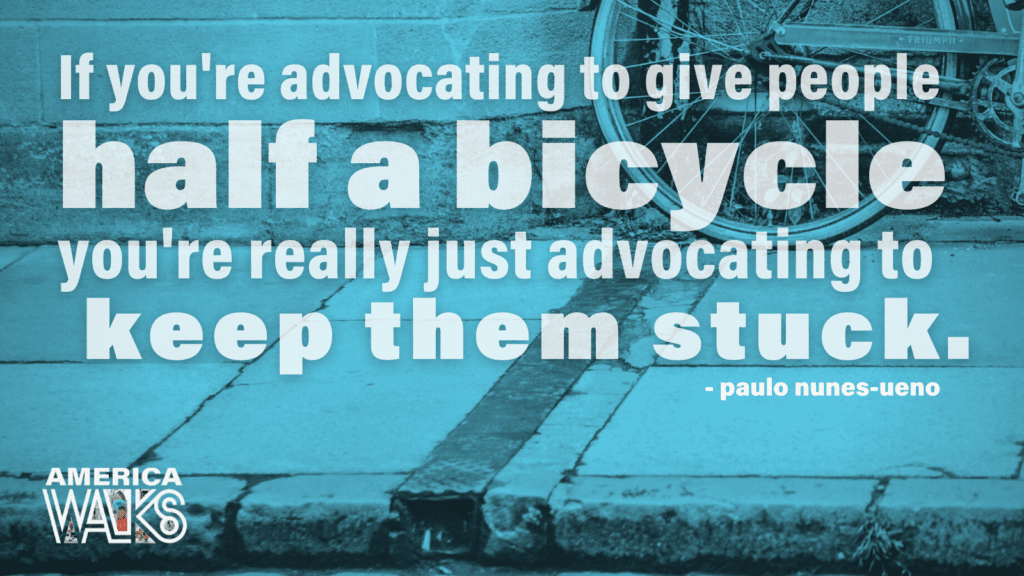
Earlier this month, America Walks hosted a webinar about equity, transit, and how we can better center the voices of nondrivers. Moderated by Claire Stanley, a public policy analyst at the National Disability Rights Network, the conversation included serious issues. But there were moments of levity, too. Like, when asked by an audience member how to confront the idea that electric cars are a silver bullet, Anna Zivarts, of Disability Rights Washington, could barely stifle a knowing chuckle.
“I…I shouldn’t…” she said through a low laugh.
Both Anna and Paulo Nunes-Ueno, of Front and Centered, are familiar with this subject. Electric cars, hailed by supporters as an eco-friendly solution to numerous problems. But, as Paulo pointed out, an electric car — even a self-driving one—is still a car.
“Nobody who is stuck in traffic stops and says, ‘well, at least I am in an electric car,'” Paulo explained. “Nobody circling the parking garage and trying to find a place to park says, ‘at least I am in an EV.’ Nobody whose child who was killed in a car accident says, ‘well at least she was killed by an electric vehicle.’ The notion that we are going to get to a just transportation system by baking in the inequities and perversions of the one that we have, by simply electrifying cars is just wrong on its face.”
Confronting misconceptions, highlighting successes
The goal of the hour-long event was to highlight the ways in which nondrivers are often kept from important conversations. Nondrivers—whether due to age, income, or disability—are the most directly impacted by policy decisions. They are often seniors, individuals living below the poverty line, pr those with disabilities. Some nondrivers have been incarcerated and are not permitted to drive. And still others simply don’t wish to contribute to climate change.
For nondrivers, decisions around density, safety, and city planning can dramatically change the quality of life for those who can’t hop in the car whenever they want. And yet, they are rarely centered in these conversations.
“In Washington state right now, because of the economic growth we’ve had, the places in our state that are most walkable and have the best transit service have become really unaffordable for many folks,” stated Anna. She added that the population being pushed into less accessible areas include “many folks with disabilities who are on a fixed income.”
Anna went on to say:
What we see is whether people want to or not, they are living further and further out in suburban or exurban or rural communities. And they still need transit. And they still need safe places to walk and roll.
It is not impossible for us to have pathways to rural areas, multi-use pathways that offer the opportunity to get from point A to point B…We have this historically and we can have again. It’s just a matter of priorities.

A #WeekWithoutDriving, a week of realizations
We also invited Anna and Paulo to share some recent advocacy wins. They told us about the #WeekWithoutDriving, a campaign which prompted more than 100 decision-makers to get out of their cars for an entire week. The experiment left many lawmakers and transportation officials with a greater understanding of the plight of nondrivers.
The most “glaring” issue, said Louisa Miller, Seattle’s project manager for Vision Zero, was time. On the Seattle Department of Transportation blog, she noted that “it was simply not possible to run errands or get to where I needed to go within the time it would take to walk or take transit. The inherent benefit this provides to people driving, and the burden it places on those without the ability to drive, was staggering.”
“We did hear quite a few interesting responses from legislatures in our state,” Anna noted. “Some are very kind and explained to us why they could not participate because this is where they live and this is what their life was like.”
But, she explained, even the rejections were telling.
“Even for the folks who said no, having to think about it and send that email, was great. It was a real step forward.”
Did you miss this important and fascinating conversation? You can watch the entire thing here:
Both Anna and Paulo provided a number of incredible resources. Find those below:
- The Disability Mobility Initiative website has a lot of images, videos, and information about the work that they’re doing.
- Disability Rights Washington also created an incredible research paper about transportation rights and access, specifically focusing on nondrivers. You can find that here.
- Front and Centered has a number of ongoing campaigns. Learn about those and find their Transportation Bill of Rights here.
And, of course, if you found this webinar valuable, we’d love it if you could contribute to America Walks! Your financial support ensures that we can continue to offer education and outreach like this in the future. https://americawalks.org/donate/